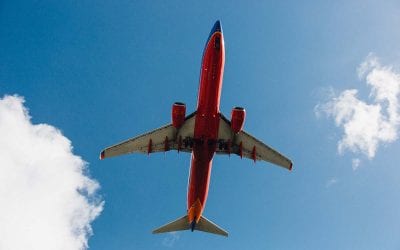Although two recent airplane crashes resulted in all deaths, many passengers and crew survive most crashes. I have 14 tips to help you survive airline crashes.

American Airlines A319 landing at Philadelphia International Airport. Copyright © 2018 NSL Photography. All Rights Reserved.
The nation was rocked by two fatal airplane crashes last week. One involved a scheduled airline, and the other a medical transport jet. Though all died, many times, passengers survive airline crashes.
Last Wednesday, American Airlines flight 5342 collided in mid-air with a U.S. Army Black Hawk helicopter at Ronald Reagan Washington National Airport. All 67 people on the two aircraft died. Last Friday, a Med Jet air ambulance crashed shortly after takeoff from Northeast Philadelphia Airport. All six on board and one person on the ground were killed.
Since then, air travelers have been seriously questioning airline safety, as they should. Many actions should be taken to improve air travel safety in the U.S., including finally finishing the modernization of the air traffic control system and moving to the new Next Generation Air Transportation System (NextGen). It’s still five years from completion.
Generally, airlines are safe. The American Airline crash resulting in 67 fatalities was the first fatal crash of a scheduled commercial airliner in the U.S. since October 2019, with billions of U.S. passengers flying safely in between.
That said, if we look at U.S. air travel statistics, we learn that it’s generally safe despite its periodic accidents and subsequent fatalities. The U.S. handles over ten million scheduled commercial passenger flights each year, carrying over 2.9 million passengers daily. The American Airlines mid-air collision crash was the first fatal crash of a scheduled commercial airline since PenAir flight 3296 crashed in October 2019, with eleven seriously injured and one fatality.
Since the flight 5342 mid-air collision, friends have asked me if airplane accidents are ever survivable and what passengers can do to improve their survival odds.
According to the NTSB, your chances of surviving an incident/crash are 97.3 percent.
In the NTSB (National Transportation Safety Board) report on Survivability of Accidents Involving Part 121 US Air Carrier Operations: 2020 Update we see that from 1983–2017 there were 2,973 fatalities on flights carrying 108,701 passengers that had serious injuries and/or fatalities. These incidents/accidents occurred in the air, as well as in crashes on land and sea. Seventy-seven percent of the fatalities occurred on flights prior to 2001. Including all the flights from 1983–2017, 97.3 percent of the passengers and crew survived. Airplane accidents are mostly survivable.
It can be frightening.
I know what it’s like to be in an airplane accident. I was on a winter flight taking off from Pittsburgh and lost all power to the cabin, cockpit, and instruments. The pilot aborted takeoff. With the brakes smoking and the thrust reversers screaming, we heard, “Brace! Brace! Brace!” The guy sitting next to me wet his pants. My heart raced. We finally stopped with the nose gear well past the end of the runway. Instructions were yelled out. The doors opened. The emergency chutes were extended. There were a few bumps and bruises, and one woman who refused to take off her high heels got one stuck on the chute and broke her leg.
Here are my fourteen tips for passengers to enhance incident/crash survival chances.
If you do nothing else to prevent yourself from being injured or possibly die in an airplane incident/crash, wear your seatbelt at all times on your flight while you’re in your seat.
Fasten your seatbelt and leave it fastened:
Once the fasten your seatbelt sign goes on, every second that you’re in your seat, even if it’s a lie-down seat and you’re sleeping, keep your seatbelt fastened snugly enough to hold you in place in case of turbulence or an accident. Don’t release the seat belt until your plane is stopped at the gate of your destination airport.
Check for your life vest:
Particularly if your plane is flying over a major body of water, look under your seat to be sure a life vest is there. If it’s missing, immediately report it to your flight attendant.
Read the safety information card:
Read the card and pay attention to the pre-flight safety speech, even if you’ve heard it before. It’s good to refresh your memory.
Devise an evacuation plan in case of an incident/accident by learning where the nearest exits are. Count rows in case smoke fills the cabin so you can’t see the exits. Be particularly alert during the first and last minutes of flight when most accidents occur.
Devise an evacuation plan:
Count the rows from your seat to the two closest exits, fore and aft, in case smoke fills the plane, obscuring your sight, or fire blocks one of your exits. Be aware of the closest exit forward when in the back of the plane. The rear exits are often not opened after a water landing.
Be particularly alert at take-off and landing:
About 80 percent of accidents occur during the first 3 to 5 minutes of flight and the last 10 minutes. Stay alert at those times. Keep your shoes on; don’t use earplugs, earbuds, or headsets during those times of heightened danger.
In winter, consider keeping your coat or jacket with you during take-off and landing:
I don’t stow my coat or jacket in the overhead bin until well after takeoff in winter and have them with me during landing, in case of an accident. If you have to evacuate your plane, you need to get out as fast as possible while the plane could still catch fire and explode. There’s really no time to stand, open the overhead bin, and grab your belongings if you want to enhance your survival, and you don’t want to be the one who stops other passengers by blocking the aisle to get your coat or bag.
If you’re told you may crash:
If you’re alerted to prepare for a crash, stay calm. The odds are with you.
Listen to the crew’s instructions if given, but don’t wait to evacuate the plane once it stops, as the crew may be dazed or injured.
Listen to the crew’s instructions if given:
The crew is trained to help in emergencies. Listen to their instructions.
Don’t wait for flight attendant instructions:
They may be dazed or injured and can’t give directions. As soon as the plane comes to a stop, move quickly to the nearest exit.
Don’t take anything with you while evacuating the plane. You shouldn’t push or block the aisle.
Don’t take anything with you:
You’ll need your hands free to keep your balance in the aisle to step over debris or luggage or if pushed by passengers, who might be panicking.
Don’t push:
It won’t help you get through faster. You might incite a hysterical passenger.
At the exit door, check before opening it:
If the exit door’s not open, look out of its window to see if there’s fire. When there’s fire, check that door on the other side of the plane.
If you’re on land, get as far away from the plane as possible in case of explosion. On water, don’t jump in the water until and unless you have no other choice.
If you’re on land:
Once you’re out of the plane, get as far from the crash as possible in case a fire starts, especially if the fuel explodes. If you spot a large object to shield you, get behind it as long as it’s not too close to the crash. When planes explode, thousands of fragments will go every which way and can be fatal.
If you’re on water:
Once you’re out of the plane, inflate your life vest. Put your arms through the loops if you only have a seat cushion. They really float. Don’t jump in the water unless you have no choice. Most water throughout the world is cold enough to cause hypothermia. Most commercial planes are equipped with rafts, often located in the cabin ceiling, and the emergency ramps can also act as rafts.
You have a chance if you’re caught in an emergency incident or crash. When U.S. Airways flight 1549 (Miracle on the Hudson) was going down into the Hudson River in New York City, no one expected everyone to survive, but they did. Follow the above advice and listen to the flight crew. It can help you save your life.
READ ALSO:
Having a unified pilot rule isn’t as simple as it sounds
How airline passengers are deceived by seat reservation games
After many years working in corporate America as a chemical engineer, executive and eventually CFO of a multinational manufacturer, Ned founded a tech consulting company and later restarted NSL Photography, his photography business. Before entering the corporate world, Ned worked as a Public Health Engineer for the Philadelphia Department of Public Health. As a well known corporate, travel and wildlife photographer, Ned travels the world writing about travel and photography, as well as running photography workshops, seminars and photowalks. Visit Ned’s Photography Blog and Galleries.



